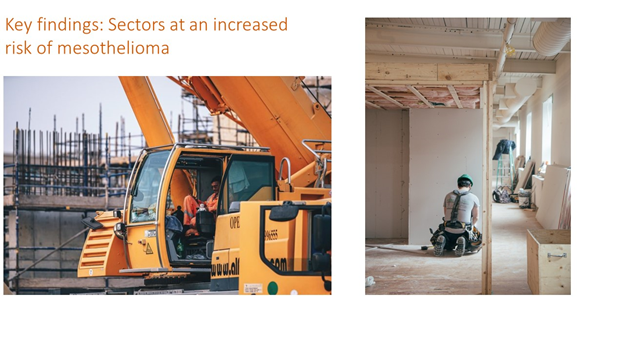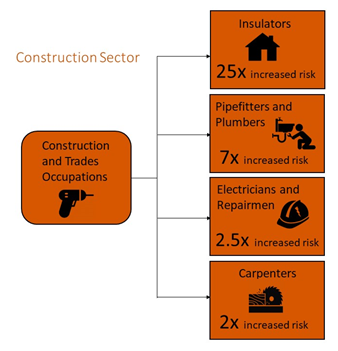Disease Background
What is mesothelioma?
Mesothelioma is a cancer of the tissue lining the lungs and other organs. Mesothelioma is the most well-known modern occupational cancer dating back to the 1950s when asbestos miners experienced high rates of this highly fatal disease. It is characterized by a long latency, upwards of 40 years, after exposure to asbestos fibers. There is no cure and survival is extremely poor with only 10% of cases living five years after being diagnosed. Men are more likely to be diagnosed than women, but second-hand exposure to asbestos through clothing washing is a historic risk factor for mesothelioma in women. The diagnostic difference in sex is due to more men working in environments with asbestos than men being more susceptible to women.
Risk factors
- Asbestos fibers
- Ionizing radiation
Approximately 80% of mesothelioma cases are attributable to occupational asbestos exposures. There are several types of asbestos fiber, including chrysotile asbestos, which is the most widely used fiber. All fiber types are known to cause mesothelioma. Asbestos was heavily mined in the early and mid 20th century and used across a variety of applications due to its favourable thermal and tensile properties.
Why are we interested?
There are multiple occupations and industries that have consistently shown increased risks of mesothelioma. The recent national asbestos ban (link) is a positive step to reduce the health burden of mesothelioma, but exposure to asbestos is an ongoing concern. Using the occupational disease surveillance system (ODSS), we sought to identify workplace trends for mesothelioma in Ontario.
Key Findings


Within the construction industry, ODSS results indicate that insulating occupations, pipefitters and plumbers, electricians and repairmen and carpenters are all at elevated risks of mesothelioma. Insulating occupations require workers to handle asbestos materials when either installing or removing insulation materials from homes. Pipefitters and plumbers as well as electricians and repairmen are required to work within wall spaces in buildings, which potentially exposes them to insulating materials, such as asbestos. Disturbing these materials can lead to the inhalation of asbestos fibers.
 Workers within the education and related services sector include teachers and administrative staff. These workers are possibly exposed to asbestos that was installed as pipe insulation in older school and university buildings. The degradation of these buildings can lead to water damage, which can volatilize asbestos and pose a health risk to staff. ODSS results indicate that university and college staff as well as elementary and secondary school staff are at increased risks of mesothelioma. While these findings may not appear obvious given the clerical and teaching tasks of education workers, these associations have been previously observed and are supported in the scientific literature.
Workers within the education and related services sector include teachers and administrative staff. These workers are possibly exposed to asbestos that was installed as pipe insulation in older school and university buildings. The degradation of these buildings can lead to water damage, which can volatilize asbestos and pose a health risk to staff. ODSS results indicate that university and college staff as well as elementary and secondary school staff are at increased risks of mesothelioma. While these findings may not appear obvious given the clerical and teaching tasks of education workers, these associations have been previously observed and are supported in the scientific literature.

Unlike Quebec, Ontario’s asbestos mining was not a large industry. Nevertheless, ODSS results indicate that asbestos miners in Ontario are at a dramatically increased risk of mesothelioma relative to other Ontario workers. This is expected given the known etiology of mesothelioma and the extraordinarily high levels of exposure asbestos miners would incur.
 Iron and steel mill workers are required to operate machinery, including boilerplates, furnaces, and other heating apparatuses. Asbestos was commonly used as an insulating material in metalworking machinery. When these materials are disturbed or degrade asbestos fibers are released into the air. ODSS results demonstrate that iron and steel workers are at an increased risk of mesothelioma relative to other Ontario workers.
Iron and steel mill workers are required to operate machinery, including boilerplates, furnaces, and other heating apparatuses. Asbestos was commonly used as an insulating material in metalworking machinery. When these materials are disturbed or degrade asbestos fibers are released into the air. ODSS results demonstrate that iron and steel workers are at an increased risk of mesothelioma relative to other Ontario workers.
Risk by Industry and Occupation
FIG1. Incidence of Mesothelioma diagnoses among workers employed in each industry group relative to all others, Occupational Disease Surveillance System (ODSS), 1983-2016

The hazard ratio is an estimate of the average time to diagnosis among workers in each industry/occupation group divided by that in all others during the study period. Hazard ratios above 1.00 indicate a greater incidence of disease in a given group compared to all others. Estimates are adjusted for birth year and sex. The width of the 95% Confidence Interval (CI) is based on the number of cases in each group (more cases narrows the interval).
FIG2. Incidence of Mesothelioma diagnoses among workers employed in each occupation group relative to all others, Occupational Disease Surveillance System (ODSS), 1983-2016

The hazard ratio is an estimate of the average time to diagnosis among workers in each industry/occupation group divided by that in all others during the study period. Hazard ratios above 1.00 indicate a greater incidence of disease in a given group compared to all others. Estimates are adjusted for birth year and sex. The width of the 95% Confidence Interval (CI) is based on the number of cases in each group (more cases narrows the interval).
Table of Results
Table1. Surveillance of Mesothelioma: Number of cases, workers employed, and hazard ratios in each industry (SIC)
| SIC Code * | Industry Group | Number of cases | Number of workers employed | Hazard Ratio (95% CI) † |
| 1 | Agriculture | 11 | 35,119 | 0.81 (0.45, 1.47) |
| 2/3 | Forestry, Fishing and Trapping |
<5 | 10,722 | — |
| 4 | Mines, Quarries and Oil Wells |
21 | 23,230 | 1.63 (1.06, 2.52) |
| 5 | Manufacturing | 340 | 694,923 | 1.10 (0.95, 1.26) |
| 6 | Construction | 170 | 211,572 | 1.87 (1.58, 2.22) |
| 7 | Transportation, Communication and Other Utilities |
83 | 197,583 | 1.00 (0.80, 1.26) |
| 8 | Trade | 93 | 429,967 | 0.55 (0.44, 0.68) |
| 9 | Finance, Insurance and Real Estate |
6 | 24,021 | 0.76 (0.34, 1.70) |
| 10 | Community, Business and Personal Service |
126 | 600,448 | 0.89 (0.74, 1.09) |
| 11 | Public Administration and Defense |
82 | 191,139 | 1.24 (0.99, 1.56) |
| * SIC: Standard Industrial Classification (1970) | ||||
| † Hazard rate in each group relative to all others | ||||
Table2. Surveillance of Mesothelioma: Number of cases, workers employed, and hazard ratios in each occupation (CCDO) group
| CCDO Code * | Occupation Group | Number of cases | Number of workers employed | Hazard Ratio (95% CI) † |
| 11 | Managerial, administrative and related |
15 | 31,037 | 2.73 (1.64, 4.56) |
| 21 | Natural sciences, engineering and mathematics |
12 | 26,369 | 1.28 (0.73, 2.27) |
| 23 | Social sciences and related fields |
<5 | 30,728 | — |
| 25 | Religion | 0 | 129 | — |
| 27 | Teaching and related | 9 | 48,524 | 1.43 (0.74, 2.77) |
| 31 | Medicine and health | 17 | 135,475 | 1.04 (0.63, 1.71) |
| 33 | Artistic, literary, recreational and related |
<5 | 15,009 | — |
| 41 | Clerical and related | 35 | 197,593 | 0.62 (0.44, 0.87) |
| 51 | Sales | 20 | 148,272 | 0.59 (0.38, 0.93) |
| 61 | Service | 77 | 371,368 | 0.74 (0.58, 0.94) |
| 71 | Farming, horticultural and animal husbandry |
12 | 50,269 | 0.62 (0.35, 1.09) |
| 73 | Fishing, hunting, trapping and related |
0 | 558 | — |
| 75 | Forestry and logging | <5 | 10,710 | — |
| 77 | Mining and quarrying, including oil and gas field |
7 | 13,046 | 0.97 (0.46, 2.04) |
| 81 | Processing (mineral, metal, chemical) |
33 | 79,386 | 0.97 (0.68, 1.37) |
| 82 | Processing (food, wood, textile) |
19 | 99,382 | 0.50 (0.32, 0.79) |
| 83 | Machining and related | 109 | 189,800 | 1.20 (0.98, 1.47) |
| 85 | Product fabricating, assembling and repairing |
157 | 328,825 | 1.05 (0.89, 1.26) |
| 87 | Construction trades | 223 | 216,117 | 2.55 (2.18, 2.98) |
| 91 | Transport equipment operating |
54 | 168,487 | 0.69 (0.53, 0.92) |
| 93 | Materials handling and related, not elsewhere classified |
55 | 153,323 | 0.80 (0.61, 1.06) |
| 95 | Other crafts and equipment operating |
20 | 28,360 | 1.61 (1.03, 2.51) |
| 99 | Other occupations not elsewhere classified | 85 | 215,629 | 0.90 (0.72, 1.13) |
| * CCDO: Canadian Classification Dictionary of Occupations (1971) | ||||
| † Hazard rate in each group relative to all others | ||||
